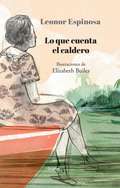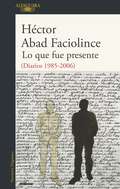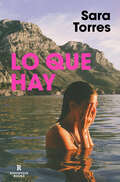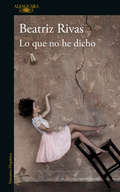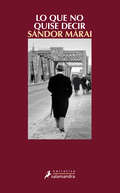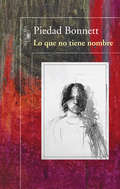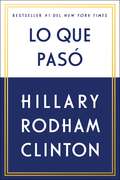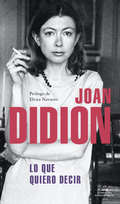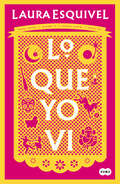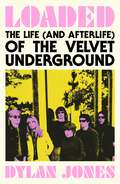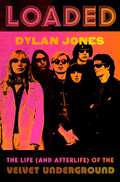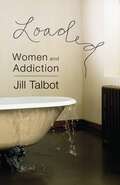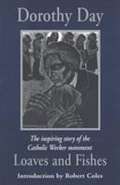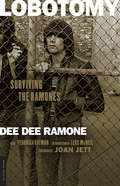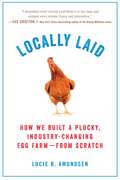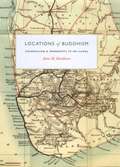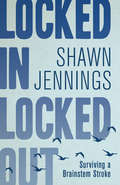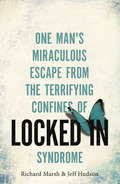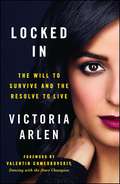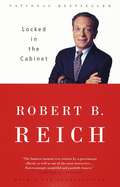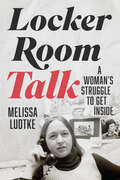- Table View
- List View
Lo que cuenta el caldero
by Leonor EspinosaPor primera vez Leonor Espinosa, la chef más destacada de América Latina en la actualidad, publica las crónicas culinarias que ha escrito a lo largo de su trayectoria y en los miles de recorridos que ha hecho por Colombia y otros lugares del mundo. Lo que cuenta el caldero reúne el legado gastronómico Leonor Espinosa a través de paisajes sonoros y humeantes y sus experiencias en territorios de Colombia en los que la cocina es protagonista. Acompañados de ilustraciones de Elizabeth Builes y recetas cuidadosamente seleccionadas, cada uno de los relatos aquí agrupados transmite los sabores y aromas que marcaron la infancia de la autora y revela las preparaciones que hoy son esenciales en su fogón: el plátano maduro, el suero costeño, el mote de queso y la yuca "sancochá", entre otras.
Lo que cuenta el caldero
by Leonor EspinosaPor primera vez Leonor Espinosa, la chef más destacada de América Latina en la actualidad, publica las crónicas culinarias que ha escrito a lo largo de su trayectoria y en los miles de recorridos que ha hecho por Colombia. Lo que cuenta el caldero reúne el legado gastronómico Leonor Espinosa a través de paisajes sonoros y humeantes y sus experiencias en territorios de Colombia en los que la cocina es protagonista. Acompañados de ilustraciones de Elizabeth Builes y recetas cuidadosamente seleccionadas, cada uno de los relatos aquí agrupados transmite los sabores y aromas que marcaron la infancia de la autora y revela las preparaciones que hoy son esenciales en su fogón: el plátano maduro, el suero costeño, el mote de queso y la yuca "sancochá", entre otras.
Lo que fue presente
by Héctor Abad Faciolince«Parece que no soy capaz de ser, si es que pretendo ser algo. No soy nada: un escritor que no escribe nada, salvo un diario. Un amante que no es capaz de amar. Un padre que no ejerce.Un marido lejano». Los diarios íntimos de Héctor Abad Faciolince pueden leerse como una novela de formación. Aquí se incluyen los que van desde finales de 1985 (cuando era un estudiante de 27 años) hasta la publicación de su libro más aclamado, El olvido que seremos, en 2006. En ellos se relatan las angustias de alguien que, aunque quería ser escritor, escribía muy poca ficción y mucho sobre sus obsesiones, sus amores y sus dificultades en la vida cotidiana. Abad quería dejar escrito, al menos, que era incapaz de escribir. Un testimonio descarnado sobre cómo nace una vocación y cómo se aprende a enfrentar la dura y emocionante aventura de vivir. La crítica ha dicho sobre el autor y su obra: «La más apasionante experiencia de lector de mis últimos años». Mario Vargas Llosa (Sobre El olvido que seremos) «Héctor Abad ha escrito una historia trágica e inolvidable». J. M. Coetzee (Sobre El olvido que seremos) «[#] una metáfora de la belleza, la felicidad y la pérdida; un libro sobre la vida en todas sus facetas». Juan Cruz, El País, España (Sobre La Oculta) «Este es un libro que serenamente conoce cómo es el ser humano, y cómo acortar, o reconciliar, la distancia entre el cuerpo y la mente». The Guardian, Reino Unido (Sobre Tratado de culinaria para mujeres tristes)
Lo que hay
by Sara TorresEl esperado debut narrativo de la premiada poeta Sara Torres: una memoria sobre el duelo, el deseo y el amor entre mujeres, madres e hijas. «Un libro luminoso. Enhebra una búsqueda preciosa para narrar de forma única y diferente todo aquello que nos atraviesa y nos duele». María Sánchez Mientras su madre muere de cáncer en una ciudad del norte, la narradora hace el amor con una mujer en un hotel de Barcelona. Tiene un vuelo para visitar a su madre la mañana siguiente, pero ya llegará tarde. Poco después, su amante desaparece de forma brusca y definitiva. Cuando su pareja vuelve de Londres para instalarse con ella en un pequeño apartamento junto al mar, esta intenta ser la calma que sostenga la angustia de un cuerpo que llora a una madre y anhela a una amante. «Amar es amar siempre después de mi madre. No puedo hablar con mamá, tampoco con Ella. Mi vida se ha suspendido con la interrupción de esas dos conversaciones». La autora retoma ese diálogo en este libro para indagar en las aristas del abandono y el anhelo y tratar de entender a una madre que marcó la vida y las maneras de su hija con su arrolladora forma de amar. El debut narrativo de la premiada poeta Sara Torres conjuga lirismo y honestidad para navegar el duelo, el amor y el deseo, su búsqueda y su pérdida. El resultado de la travesía es un mapa de las grietas que nos hacen humanos; una invitación a acariciar sin miedo los surcos que nos conforman. La crítica ha dicho:«Veo a Sara Torres como una reencarnación de todas esas filósofas, narradoras y poetas que hicieron temblar los cimientos de la literatura con sus teorías sobre el amor, la amistad y las relaciones humanas. En su narrativa hay candidez, en su lirismo hay contundencia y en sus ideas hay todo un despliegue de erudición. La admiraba en su papel de poeta; ahora, como novelista, la amo».Luna Miguel «Amamos torpemente, llevando a la espalda una mochila pesada de legados y de heridas. Pero amamos, y eso construye mundos. La mirada poética de Sara Torres los explora con lucidez y valentía, y ofrece así una compañía dulce para nuestras propias búsquedas».Laura Casielles «Lírica, honda y auténtica.»Woman «Una conversación íntima y política acerca de los vínculos del amor y su articulación en los estados del cuerpo: el sexo, la enfermedad, la pasión, el duelo y la escritura».Meri Torras, Doctora en Teoría de la literatura y literatura comparada por la UAB
Lo que no he dicho
by Beatriz Rivas«¿Pesara más un edificio sobre mi cuerpo... o una muerte sobre mi conciencia?» ¡Esta temblando! Un romance a escondidas. Un departamento en la colonia Roma. Los objetos se desploman, las paredes se agrietan. « Moriremos?» La escala de Richter es alta y la fatalidad, tambien. Gritos. El pavor crece y se quiebra; de las fisuras manan los recuerdos de ella que, aterrorizada, espera la caida. Como destellos de vida, se dispara el recuento final de una historia hecha de tantas otras. Se desprenden los mosaicos de sus vivencias, amorios, viajes, infancia feliz... o remendada? Matrimonios, divorcios, una hija sabia, genial y entrafiable . Existen los recuerdos o son visiones desesperadas de un aqui que se derrumba? El pecado de omisión y la culpa taladran la memoria de esta enamoradiza agnóstica, mientras crujen las entrafias de la tierra. El desafio que tiene por delante consistira en contarlo todo a riesgo de que solo las piedras y el polvo la escuchen. En esta intima y emotiva novela, Beatriz Rivas compone un collage de confesiones, pensamientos, desahogos, manias, banalidades y fantasmas que se entrelazan entre hondos cuestionamientos. Un rompecabezas para los voyeuristas del alma donde se unen placeres y heridas; un caleidoscopio de voces que gira concéntrico y revelador. Loque no he dicho es una expiación a la velocidad del miedo...
Lo que no quise decir
by Sándor Márai«No dejaré que los dos primeros capítulos de Confesiones de un burgués III lleguen al público extranjero. No quiero que lean esta triste confesión, esta acusación entre húngaros. En húngaro, para los húngaros, sí... Pero que los extranjeros no lo sepan.» Una entrada del diario de Márai de 1949 permitió confirmar a los especialistas del museo Petófi de Budapest lo que ya sospecharon cuando, entre el material del legado literario recibido en 1997, encontraron unos capítulos inéditos que, por deseo del propio Sándor Márai, se habían excluido de la tercera parte de Confesiones de un burgués, editada en Toronto en 1971 con el título ¡Tierra, tierra! Así, estos textos inéditos constituyen una parte crucial de la autobiografía de Márai puesto que giran en torno a dos fechas capitales: el 12 de marzo de 1938, cuando la Alemania nazi se anexionó Austria, y el 31 de agosto de 1948, cuando el gran autor húngaro, acompañado de su esposa y su hijo, abandonó su país, entonces ya un satélite de la Unión Soviética. «En aquellos diez años dejó de existir toda una forma de vida y toda una cultura», escribe. Combinando la confesión íntima con el análisis histórico, Sándor Márai evoca ese período crucial para Hungría y sondea una sociedad que se debate entre el deseo de independencia y los sueños de grandeza nacional, y que acabaría al servicio de la Alemania nazi. Este libro, una verdadera denuncia del fascismo y la barbarie, descubre a un humanista comprometido, un hombre consecuente que desea para su país una vía alternativa a la del estado totalitario. Obra de profunda integridad intelectual, Lo que no quise decir es el testimonio excepcional de uno de los grandes escritores europeos de siglo XX. Reseñas:«La lucidez incisiva de Márai está marcada por un profundo desencanto, una decepción inconsolable. Describe el hundimiento de los valores culturales de la burguesía húngara y el fracaso de la Europa intelectual y cultivada a la que pertenecía.»Lire «El propio Márai está presente en este nuevo libro [...]. Vemos al escritor que padece tragedias personales (en 1938 perdió al hijo esperado durante largo tiempo) y seguir la transición entre su vida de periodista de éxito y la de en un escritor que, fiel a sus principios, se quedó completamente solo y vivió sin ningún tipo de reconocimiento y éxito durante la segunda parte de su vida.»Litera «Un texto de gran fuerza, en el que Sándor Márai desmenuza la extinción de la filosofía humanista a manos de los nazis y del régimen estalinista.»Télérama
Lo que no tiene nombre
by Piedad BonnettUn relato conmovedor. ¿Hasta dónde puede llegar la literatura? En este libro dedicado a lavida y la muerte de su hijo Daniel, Piedad Bonnett alcanza con laspalabras los lugares más extremos de la existencia. La naturalidad y laextrañeza conviven en sus páginas igual que en su mirada conviven lasequedad de la inteligencia y el latido más intenso de la emoción.Buscar respuestas es sólo un modo de hacerse preguntas, de negociar conlas preguntas, de saber cuántas preguntas caben en una obsesión.
Lo que pasó
by Hillary Rodham Clinton“Una cautivadora obra, maravillosamente sintetizada, que no se puede soltar” (Slate). Best seller #1 del New York Times y el Libro del Año #1 de No-ficción de la revista Time: El tomo de memorias más personal de Hillary Rodham Clinton hasta ahora sobre la elección presidencial de 2016.En este libro de memorias “cándido y tragicómico” (The New York Times), Hillary Rodham Clinton revela lo que pensaba y sentía durante una de las más controversiales e impredecibles elecciones presidenciales de la historia. Nos lleva dentro de una experiencia personal intensa de haber sido la primera mujer nominada para presidente por un importante partido en una elección marcada por ira, sexismo, excitantes altas y exasperantes bajas, giros más raros que en una obra de ficción, interferencia rusa, y un opositor que violó todas las reglas. “En su obra más emocionalmente cruda” (People), Hillary describe la experiencia de su candidatura para presidente contra Donald Trump, los errores que cometió, cómo ha lidiado con una traumática y devastadora derrota, y cómo encontró fuerzas para levantarse después. Les cuenta a los lectores lo que requirió poder sobreponerse: los rituales, las relaciones, y lecturas que la ayudaron a superarlo todo y lo que la experiencia le enseñó acerca de la vida. En este “manifiesto feminista” (The New York Times), ella habla de los desafíos de ser una mujer fuerte en el ojo público, las críticas sobre su voz, su edad y su apariencia, y la doble moral que confrontan las mujeres en la política. A la vez que ofrece una “vigorizante... guía de nuestro escenario político” (The Washington Post), Lo que pasó expone cómo la elección de 2016 resultó marcada por un asalto sin precedente contra nuestra democracia por un adversario extranjero. Analizando la evidencia y atando cabos, Hillary muestra simplemente lo peligrosas que son las fuerzas que moldearon el resultado, y por qué los americanos necesitan entenderlas para proteger nuestros valores y nuestra democracia en el futuro. La elección de 2016 no tuvo precedente y fue histórica. Lo que pasó es el recuento de esa campaña, ahora con un epílogo que muestra cómo Hillary forcejeó con muchos de sus peores miedos que se están haciendo realidad en la Era de Trump, mientras encontraba esperanza en un surgimiento de activismo cívico, mujeres postulándose a cargos, y jóvenes marchando en las calles.
Lo que quiero decir
by Joan DidionUna colección atemporal de algunos de los primeros artículos y crónicas de la icónica escritora y periodista norteamericana. «Una excelente introducción a la aguda mirada de Didion sobre la vida estadounidense.»Bethanne Patrick, The Washington Post «Escribo estrictamente para averiguar qué estoy pensando, qué estoy mirando, qué veo y qué significa.» Lo que quiero decir recopila doce artículos y crónicas inéditas en español de Didion bajo el eje vertebrador de lo que el Nuevo Periodismo llamó "el narrador testigo". Redactados en la primera parte de su carrera como periodista, estos concisos e incisivos textos muestran los intereses primarios que la convirtieron en escritora y abarcan un amplio espectro de sus temas habituales, desde el acto de escribir a la crónica social o política. Por sus páginas desfilan personajes como Orwell, Hemingway, Mapplethorpe, Nancy Reagan, anónimos de Ludópatas Anónimos o el propio director de admisiones de la Universidad de Standford, donde fue rechazada. Didion es uno de los iconos culturales de Estados Unidos y una de las figuras clave del periodismo de las últimas cinco décadas, y en sus crónicas, como apunta el prólogo de Elvira Navarro, «refleja, como pocos autores, un mundo, el estadounidense, que, para bien y para mal, ha extendido sus tentáculos por todo el orbe, hasta el punto de que hoy resulta imposible comprender la cultura y los acontecimientos políticos y económicos más recientes de los países occidentales (España entre ellos) sin mirar a Estados Unidos. Leerla es también, por consiguiente, adentrarnos en lo que nos ha sucedido a todos en las últimas décadas». La crítica ha dicho...«Didion es una cronista de nuestro mundo, una escritora que disuelve delirios compartidos para presentar la cruda realidad con estilo [...]. [Estarecopilación] destaca momentos en la progresión de Didion como creadora de palabras y reportera de hitos culturales.»Time «Esta amplia colección de artículos de Joan Didion muestra sus fortalezas como escritora de piezas breves [...]. Como siempre, su escritura es cautivadora [...]. Los fanáticos de Didion, nuevos y viejos, estarán encantados.»Publishers Weekly «Una excelente introducción a la aguda mirada de Didion sobre la vida estadounidense.»Bethanne Patrick, The Washington Post «Estos notables artículos de sus inicios como escritora destacan por su búsqueda de la verdad y la atención al detalle.»Peter Conrad, The Guardian «Una oportunidad [...] para ver de nuevo a la escritora que precedió al icono, la que estuvo al margen de la cultura, mirando hacia dentro.»Jessica Ferri, Los Angeles Times «Un acto de seducción consumado [...]. Una colección elegante y muy satisfactoria.»Kirkus «Hasido canonizada por su impecable estilo, pero las verdaderas ideas de Didion se centraron en aquello que mantiene unida a la sociedad o la desgarra.»Nathan Heller, The New Yorker
Lo que yo vi
by Laura EsquivelMemorias de la reconocida autora mexicana, salpicadas de nostalgia por el tiempo ido y de reflexiones sobre la consciencia del tiempo presente. Desde la casa donde nació, los juegos de calle durante su niñez, la música que ha servido como banda sonora de su vida hasta los movimientos sociales y el ataque terrorista contra las Torres Gemelas — que le tocó presenciar —, Laura Esquivel, la autora mexicana más leída en el mundo, nos enseña a través de un colorido mosaico de escritos lo que sus ojos vieron, las cosas de las que ha sido testigo en sus 72 años de vida. Son trece entregas que resultan por partes iguales un vínculo a nuestra historia, celebración de nuestras tradiciones, un comentario social y la narración de emocionales recuentos de las memorias de Laura y toda una generación. En un constante vaivén que oscila entre si todo pasado es mejor o si vivir el presente es aquello que nos sublima como seres humanos, la autora de Como agua para chocolate nos confirma lo que sí ha comprobado: siempre es más bello contemplar con el alma que con los ojos.
Loaded: The Life (and Afterlife) of The Velvet Underground
by Dylan JonesRebellion always starts somewhere, and in the music world of the transgressive teen whether it be the 1960s of the 2020s, The Velvet Underground represent ground zero. Crystallizing the idea of the bohemian, urban, narcissistic art school gang, around a psychedelic rock and roll band - a stylistic idea that evolved in the rarefied environs of Andy Warhol's Factory - The Velvets were the first major American rock group with a mixed gender line-up; they never smiled in photographs, wore sunglasses indoors, and in the process invented the archetype. They were avant-garde nihilists, writing about drug abuse, prostitution, paranoia, and sado-masochistic sex at a time when the rest of the world was singing about peace and love. Dylan Jones' definitive oral history of The Velvet Underground draws on contributions from remaining members, contemporaneous musicians, critics, film-makers, and the generation of artists who emerged in their wake, to celebrate not only their impact but their legacy, which burns brighter than ever into the 21st century.
Loaded: The Life (and Afterlife) of the Velvet Underground
by Dylan JonesDrawing on contributions from remaining members, contemporaneous musicians, critics, filmmakers, and the generation of artists who emerged in their wake, this "monumental origin story" celebrates the legacy of the Velvet Underground, which burns brighter than ever in the 21st century (New York Times bestselling author Bob Spitz). A "Must Read" by Nylon and BookRiot Rebellion always starts somewhere, and in the music world of the transgressive teen—whether it be the 1960s or the 2020s—the Velvet Underground represents ground zero. Crystallizing the idea of the bohemian, urban, narcissistic art school gang around a psychedelic rock and roll band—a stylistic idea that evolved in the rarefied environs of Andy Warhol&’s Factory—the Velvets were the first major American rock group with a mixed gender line-up. They never smiled in photographs, wore sunglasses indoors, and invented the archetype that would be copied by everyone from Sid Vicious to Bobby Gillespie. They were avant-garde nihilists, writing about drug abuse, prostitution, paranoia, and sado-masochistic sex at a time when the rest of the world was singing about peace and love. In that sense they invented punk and then some. It could even be argued that they invented modern New York. Drawing on interviews and material relating to all major players, from Lou Reed, John Cale, Mo Tucker, Andy Warhol, Jon Savage, Nico, David Bowie, Mary Harron, and many more, award-winning journalist Dylan Jones breaks down the band&’s whirlwind of subversion and, in a narrative rich in drama and detail, proves why the Velvets remain the original kings and queens of edge.
Loaded: Women and Addiction
by Jill TalbotHaving an addiction can follow the path of a great relationship that goes sour: there's the first blush of romance, the seduction ("you know you want to"), and the downward spiral into either obsession or breaking free.Jill Talbot is no stranger to addiction. Part autobiography, part exposé, Loaded: Women and Addiction weaves Talbot's own battles with addiction with various addiction stories of other women. The result is a captivating, honest look at the allure of addiction-be it to sex, drugs, alcohol, food, adventure, or infidelity-and ultimately its betrayal.Though addiction can be seductive, if you're waking up with guilt or making choices that harm others, it's probably a clue that things are out of control. Throughout Loaded, Talbot's razor-sharp honesty, heartbreaking self-awareness, and resolve to reveal the difficult truth of her relationship with past and present addictions is humbling and sometimes gut-wrenching. In sharing her struggles and her resolve to attain control over her addictions, Talbot speaks her truth while sending a message of hope to women everywhere.
Loafing Along Death Valley Trails: A Personal Narrative of People and Places
by William CaruthersIn 1926, on the advice of his doctor, former newspaperman William Caruthers, whose writings appeared in most Western magazines during a career spanning more than 25 years, retired to an orange grove near Ontario, California. Once there, he would go on to spend much of his time during the next 25 years in the Death Valley region, witnessing the transition of Death Valley from a prospector’s hunting ground to a mecca for winter tourists.This book, which was first published in 1951, is William Caruthers’ personal narrative of the old days in Death Valley—”of people and places in Panamint Valley, the Amargosa Desert and the big sink at the bottom of America.”A wonderful read.
Loaves And Fishes
by Dorothy DayStory of the author's thirty years as a leader of the Catholic Worker movement, and the St. Joseph's House of Hospitality in New York City.
Lobotomy: Surviving The Ramones
by Legs Mcneil Dee Dee Ramone Veronica KofmanLobotomy is a lurid and unlikely temperance tract from the underbelly of rock 'n' roll. Taking readers on a wild rollercoaster ride from his crazy childhood in Berlin and Munich to his lonely methadone-soaked stay at a cheap hotel in Earl's Court and newfound peace on the straight and narrow, Dee Dee Ramone catapults readers into the raw world of sex, addiction, and two-minute songs. It isn't pretty. With the velocity of a Ramones song, Lobotomy rockets from nights at CBGB's to the breakup of the Ramones' happy family with an unrelenting backbeat of hate and squalor: his girlfriend ODs; drug buddy Johnny Thunders steals his ode to heroin, "Chinese Rock"; Sid Vicious shoots up using toilet water; and a pistol-wielding Phil Spector holds the band hostage in Beverly Hills. Hey! Ho! Let's go!
Local Wonders: Seasons in the Bohemian Alps
by Ted KooserFrom the book: Ted Kooser describes with exquisite detail and humor the place he calls home in the rolling hills of southeastern Nebraska known as the Bohemian Alps. Nothing is too big or too small for his attention. Memories of his grandmother's cooking are juxtaposed with reflections about the oldfashioned outhouse on his property. In the end, what makes life meaningful for Kooser are the ways in which his neighbors care for one another and how an afternoon walking with an old dog, or baking a pie, or decorating the house for Christmas can summon memories of his Iowa childhood. This writer is a seer in the truest sense of the word, discovering the extraordinary within the ordinary, the deep beneath the shallow, the abiding wisdom in the pithy Bohemian proverbs that are woven into his essays.
Locally Laid: How We Built a Plucky, Industry-changing Egg Farm - from Scratch
by Lucie B. AmundsenHow a Midwestern family with no agriculture experience went from a few backyard chickens to a full-fledged farm--and discovered why local chicks are better.When Lucie Amundsen had a rare night out with her husband, she never imagined what he'd tell her over dinner--that his dream was to quit his office job (with benefits!) and start a commercial-scale pasture-raised egg farm. His entire agricultural experience consisted of raising five backyard hens, none of whom had yet laid a single egg. To create this pastured poultry ranch, the couple scrambles to acquire nearly two thousand chickens--all named Lola. These hens, purchased commercially, arrive bereft of basic chicken-y instincts, such as the evening urge to roost. The newbie farmers also deal with their own shortcomings, making for a failed inspection and intense struggles to keep livestock alive (much less laying) during a brutal winter. But with a heavy dose of humor, they learn to negotiate the highly stressed no-man's-land known as Middle Agriculture. Amundsen sees firsthand how these midsized farms, situated between small-scale operations and mammoth factory farms, are vital to rebuilding America's local food system. With an unexpected passion for this dubious enterprise, Amundsen shares a messy, wry, and entirely educational story of the unforeseen payoffs (and frequent pitfalls) of one couple's ag adventure--and many, many hours spent wrangling chickens.
Locations of Buddhism: Colonialism and Modernity in Sri Lanka
by Anne M. BlackburnModernizing and colonizing forces brought nineteenth-century Sri Lankan Buddhists both challenges and opportunities. How did Buddhists deal with social and economic change; new forms of political, religious, and educational discourse; and Christianity? And how did Sri Lankan Buddhists, collaborating with other Asian Buddhists, respond to colonial rule? To answer these questions, Anne M. Blackburn focuses on the life of leading monk and educator Hikkaduve Sumangala (1827-1911) to examine more broadly Buddhist life under foreign rule. InLocations of Buddhism, Blackburn reveals that during Sri Lanka's crucial decades of deepening colonial control and modernization, there was a surprising stability in the central religious activities of Hikkaduve and the Buddhists among whom he worked. At the same time, they developed new institutions and forms of association, drawing on pre-colonial intellectual heritage as well as colonial-period technologies and discourse. Advocating a new way of studying the impact of colonialism on colonized societies, Blackburn is particularly attuned here to human experience, paying attention to the habits of thought and modes of affiliation that characterized individuals and smaller scale groups. Locations of Buddhismis a wholly original contribution to the study of Sri Lanka and the history of Buddhism more generally.
Lockdown Life: The Pandemic Experience for Older Diarists
by Nicola MadgeThe COVID-19 pandemic took many by surprise when it arrived in Britain in early 2020. Daily lives changed dramatically from March with the introduction of unprecedented restrictions and lockdowns. How did people react? This book draws on the diaries of 68 men and women aged 70 and above, capturing their thoughts and experiences over the following months. Although these older diarists considered themselves among the more fortunate at the time, their entries reveal both highs and lows. There were anxieties and frustrations but also much positivity and, often, a reluctance for an over-hasty return to pre-pandemic times. Through these personal and contemporaneous accounts, the book offers a unique contribution to our understanding of the pandemic and its significance in modern social history.
Locked In Locked Out: Surviving a Brainstem Stroke
by Shawn JenningsCan there be life after a brainstem stroke? After Dr. Shawn Jennings, a busy family physician, suffered a brainstem stroke on May 13, 1999, he woke from a coma locked inside his body, aware and alert but unable to communicate or move. Once he regained limited movement in his left arm, he began typing his story, using one hand and a lot of patience. With unexpected humour and tender honesty, Shawn shares his experiences in his struggle for recovery and acceptance of his life after the stroke. He affirms that even without achieving a full recovery life is still worth it.
Locked In: One man's miraculous escape from the terrifying confines of Locked-in syndrome
by Jeff Hudson Richard Marsh'The noises were fuzzy in the darkness. Like hearing a domestic dispute through an apartment wall. As a cop, it was a scenario I'd experienced many times as I'd approached a stranger's front door. But this was different. This time I wasn't going anywhere. I wasn't moving at all. Couldn't move at all.'In May 2009 Napa cop Richard Marsh suffered a severe stroke that submerged him in the terrifying world of a Locked-in sufferer. Brain activity remains but sufferers have no way of communicating with the outside world. In fact, 90 percent of sufferers die within four months of onset. Locked In follows Richard's extraordinary race against time. First, to prove his existence to the medical team and then to beat the odds of surviving Locked-in syndrome. Written with the intensity of a thriller, we witness astonishing moments in his journey, such as Richard finally hearing a neurosurgeon say, 'I think there's someone in here'. Now fully recovered, Richard's story is one of triumph that will captivate and inspire.
Locked In: The Will to Survive and the Resolve to Live
by Valentin Chmerkovskiy Victoria ArlenESPN personality and Paralympics champion Victoria Arlen shares her courageous and miraculous story of recovery after falling into a mysterious vegetative state at age eleven and how she broke free, overcoming the odds and never giving up hope, eventually living a full and inspiring life.When Victoria Arlen was eleven years old, she contracted two rare diseases simultaneously and fell into a mysterious vegetative state. For two years her mind was dark, but in the third year, her mind broke free, and she was able to think clearly and to hear and feel everything—but no one knew. When she was fifteen years old, against all odds and medical predictions, she was finally able to communicate through eye blinks, and she gradually regained her ability to speak and eat and move her upper body, but she faced the devastating reality of paralysis from the waist down because of damage to her spine. However, Victoria didn’t lose her strength or steadfast determination, and two years later, she won a gold medal for swimming at the London 2012 Paralympics. In Locked In, Victoria shares her never-before-published story—the pain, the struggle, the fight to live and thrive, and most importantly, the faith that carried her through. Her journey was not easy, but by believing in God’s healing power and forgiveness, she is living proof that, despite seemingly insurmountable odds and challenges, the will to survive and resolve to live can be a force stronger than our worst deterrents. Not many people get a second chance at life like Victoria has, and she made a promise to God that she would make every moment count.
Locked in the Cabinet
by Robert B. ReichLocked in the Cabinet is a close-up view of the way things work, and often don't work, at the highest levels of government--and a uniquely personal account by the man whose ideas inspired and animated much of the Clinton campaign of 1992 and who became the cabinet officer in charge of helping ordinary Americans get better jobs. Robert B. Reich, writer, teacher, social critic--and a friend of the Clintons since they were all in their twenties--came to be known as the "conscience of the Clinton administration and one of the most successful Labor Secretaries in history. Here is his sometimes hilarious, sometimes poignant chronicle of trying to put ideas and ideals into practice. With wit, passion, and dead-aim honesty, Reich writes of those in Washington who possess hard heads and soft hearts, and those with exactly the opposite attributes. He introduces us to the career bureaucrats who make Washington run and the politicians who, on occasion, make it stop; to business tycoons and labor leaders who clash by day and party together by night; to a president who wants to change America and his opponents (on both the left and the right) who want to keep it as it is or return it to where it used to be. Reich guides us to the pinnacles of power and pretension, as bills are passed or stalled, reputations built or destroyed, secrets leaked, numbers fudged, egos bruised, news stories spun, hypocrisies exposed, and good intentions occasionally derailed. And to the places across America where those who are the objects of this drama are simply trying to get by--assembly lines, sweatshops, union halls, the main streets of small towns and the tough streets of central cities. Locked in the Cabinetis an intimate odyssey involving a memorable cast--a friend who is elected President of the United States, only to discover the limits of power; Alan Greenspan, who is the most powerful man in America; and Newt Gingrich, who tries to be. Plus a host of others: White House staffers and cabinet members who can't find "the loop ; political consultant Dick Morris, who becomes "the loop ; baseball players and owners who can't agree on how to divide up $2 billion a year; a union leader who accuses Reich of not knowing what a screwdriver looks like; a heretofore invisible civil servant deep in the Labor Department whose brainchild becomes the law of the land; and a wondrous collection of senators, foreign ministers, cabinet officers, and television celebrities. And it is also an odyssey for Reich's wife and two young sons, who learn to tolerate their own cabinet member but not to abide Washington. Here is Reich--determined to work for a more just society, laboring in a capital obsessed with exorcising the deficit and keeping Wall Street happy--learning that Washington is not only altogether different from the world of ordinary citizens but ultimately, and more importantly, exactly like it: a world in which Murphy's Law reigns alongside the powerful and the privileged, but where hope amazingly persists. There are triumphs here to fill a lifetime, and frustrations to fill two more. Never has this world been revealed with such richness of evidence, humor, and warmhearted candor.
Locker Room Talk: A Woman’s Struggle to Get Inside
by Melissa LudtkeWhile sportswriters rushed into Major League Baseball locker rooms to talk with players, MLB Commissioner Bowie Kuhn barred the lone woman from entering along with them. That reporter, 26-year-old Sports Illustrated reporter Melissa Ludtke, charged Kuhn with gender discrimination, and after the lawyers argued Ludtke v. Kuhn in federal court, she won. Her 1978 groundbreaking case affirmed her equal rights, and the judge’s order opened the doors for several generations of women to be hired in sports media. Locker Room Talk is Ludtke’s gripping account of being at the core of this globally covered case that churned up ugly prejudices about the place of women in sports. Kuhn claimed that allowing women into locker rooms would violate his players’ “sexual privacy.” Late-night television comedy sketches mocked her, as newspaper cartoonists portrayed her as a sexy, buxom looker who wanted to ogle the naked athletes’ bodies. She weaves these public perspectives throughout her vivid depiction of the court drama overseen by Judge Constance Baker Motley, the first Black woman to serve on the federal bench. She recounts how her lawyer, F.A.O. “Fritz” Schwarz, employed an ingenious legal strategy that persuaded Judge Motley to invoke the Fourteenth Amendment’s Equal Protection Clause in giving Ludtke access identical to that of her male counterparts. Locker Room Talk is both an inspiring story of one woman’s determination to do a job dominated by men and an illuminating portrait of a defining moment for women’s rights.
